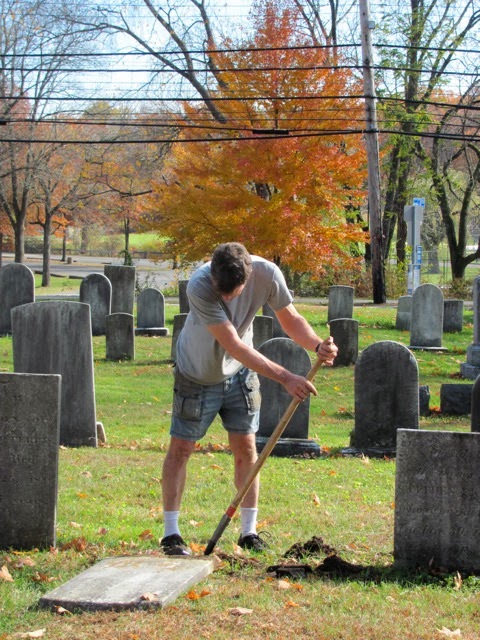Feature 2, on the other hand, clearly dates to the 1960s - but only in the sense that the stones were placed there at that time. The stones - or rather stone pillars - themselves were much earlier in date, and there are some earlier artifacts (nails, glass, etc.) mixed into the soil. However, we didn't find any artifacts in Feature 2 today, and may close it up soon.

Feature 1 continues to be the most interesting in appearance, with its two large quarried rocks, but the artifacts have begun to peter out.

That means that Feature 3 is now our star unit. That rock you see in the right corner of the trench is sitting on a big hunk of mortar. The soil around it is filled with BIG nails, glass, coal, charcoal, and slag.
Here's a plan view of Feature 3:

Archaeologist Michele, who joined our team last week, noted that there is a layer of rubble separating the two large quarried rocks and the rocks that run along the northern wall of the unit (the wall closest to the bottom of the picture). The rocks on the northern wall look as though they were mortared into place - this may be the foundation of St. Mark's, and it may continue to run underneath the soil beyond the northern wall.
Here's Michele and Eliana getting ready to screen a big bucket of soil from Feature 3, while the Merritts' stone obelisk looks on. All of the other features had become sufficiently boring at this point that we decided to assign the kids, James and Kelly, to the much more interesting task of surface surveying along the southern wall of the cemetery. And look what they found!

 These artifacts, if I had to guess, may date from the mid-19th to late-20th centuries. While all of the glass bottles and jars had seams on them (indicating that they were made in a mold), a couple were made to have corks, which could make them as early as the Civil War. A few jars had very well developed patinas on them, and others had visible letters, numbers, and whole words.
These artifacts, if I had to guess, may date from the mid-19th to late-20th centuries. While all of the glass bottles and jars had seams on them (indicating that they were made in a mold), a couple were made to have corks, which could make them as early as the Civil War. A few jars had very well developed patinas on them, and others had visible letters, numbers, and whole words.This bottle of "A&P Extracts," which I am holding together, probably dates to the early 20th century. James and Kelly also found some shells which may have come from the restaurant that was located beside the southern wall of the church for decades. They also found a nail file that may have come from the nail salon that took the restaurant's place!
While we were digging and surveying, Hans was resetting stones throughout the cemetery, including the 1818 grave of Catharine Craft, below.

This stone from 1820 was broken and couldn't be reset without cement, but Hans propped it up with a stone so that it could stand.
While digging around one grave, Hans found this assortment of objects, which we think may have been part of some sort of marker - but we're not sure.
While we were in the cemetery about a hundred bicyclists go by. You'll see these guys a lot this time of the year. They had great weather to do it today. It was in the 70s yesterday and just a little colder than that today, but tomorrow looks to see a pretty big temperature drop. Our race to finish our work for the season is on!









You mean all those objects dating back maybe a hundred years were just lying on the grass by the cemetery wall? Don't you ever clear up?
ReplyDeleteSounds like you'd better break out the combinations.
And I'm confused. If that row of mortared stones is the foundation of the church, what are the two stone blocks?